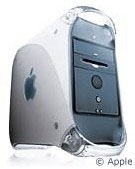Be first or be bug-free?
This is the question facing those considering adopting Mac
OS X 10.4 (Tiger). It was also the question for those who
adopted Microsoft's first version of Office for OS X - and the
earlier versions of Safari as well as a slew of other applications
from many different developers.
I had a friend ask me how come his Mac, with Tiger, kept running
a root process called "update" and then freezing up shortly
thereafter. I couldn't really tell him much, unfortunately. It
sounded like one of those early-adopter bugs that many people face.
These would include issues with screen brightness and early
versions of 10.3, PowerBook battery life and early versions of
OS X in general, and sleep mode with early versions of
10.1.
The bugs seem endless and many only show up in a few machines,
making it very hard for the developers to diagnose them.
"They should spend more time testing the software before they
release it" is the argument that comes up right about now. It's
nice in theory, but the more time spent testing the software, the
more time people have to go without an update. Time is money, and
too long a period with no updates whatsoever would turn people off
to any given company's software, no matter how good the final
version is supposed to be.
If it doesn't actually exist on store shelves, it's in reality
no good to anyone.
What would have happened if Apple had spent more time developing
OS X so that the release that ended up being 10.1 was actually
10.0? There would have been fewer complaints by the reviewers, but
also people's (and other company's) confidence in the OS would have
gone down if it took too long for it to be developed. The fact that
Apple released it as it was showed that they were making progress,
and the 10.1 update that followed proved to the public and other
software developers that Apple was indeed serious about making
OS X a completely useable OS.
While these buggy versions end up getting a lot of public
criticism, they sometimes exist as proof that a company is actively
developing the product. Microsoft Office 4.2 (which included Word
6) got pretty lousy reviews (and Word 5 was actually faster, even
in 68K emulation), but the Power Mac version showed that Microsoft
was committed to developing for the PowerPC platform.
This isn't something that only happens with software. Apple's
Power Mac 6100 was released even
before it had an OS to run on it - Apple put together version
7.1.2, which ran on the machine, nut it ran almost completely in
68K emulation. While PowerPC was supposed to be the next
generation, with the software at the time it seemed like the
usability of the machine only existed in theory.
 This also happened with the early G4s. The first low-end model that came out - both
the original 400 MHz version and the latere 350 Mhz one - was
actually based on a Yosemite (blue
G3) motherboard. It was basically the same computer but with a
G4 processor. This gave people a taste of what the G4 could do
while keeping the price down (one of the few applications to fully
utilise the G4 at the time was Photoshop). It wasn't until
OS X was developed that the operating system and most software
took full advantage of the G4 processor.
This also happened with the early G4s. The first low-end model that came out - both
the original 400 MHz version and the latere 350 Mhz one - was
actually based on a Yosemite (blue
G3) motherboard. It was basically the same computer but with a
G4 processor. This gave people a taste of what the G4 could do
while keeping the price down (one of the few applications to fully
utilise the G4 at the time was Photoshop). It wasn't until
OS X was developed that the operating system and most software
took full advantage of the G4 processor.
There will always be early adopters eager to purchase products
before they get updated and the bugs get worked out. Tiger sold
extremely well the first day it went on sale, and there are plenty
of people using it right now. But then again, there are a huge
number of people still using Panther, Jaguar, and even the classic
Mac OS.

 This also happened with the early G4s. The
This also happened with the early G4s. The 
